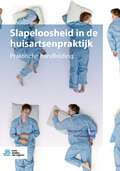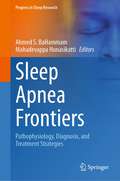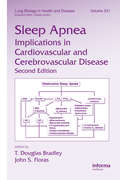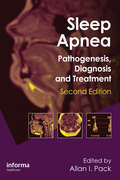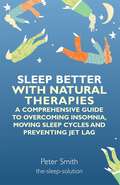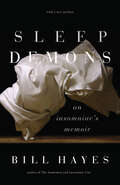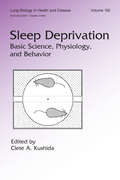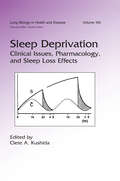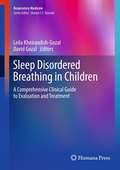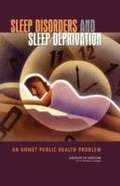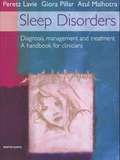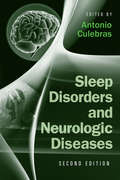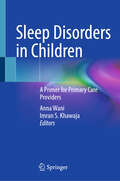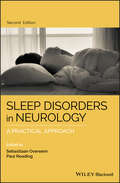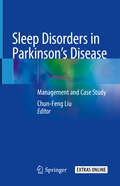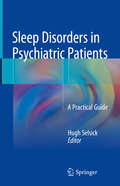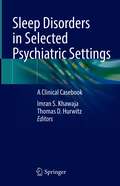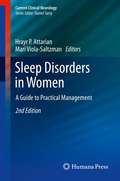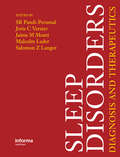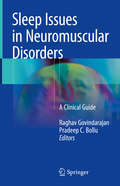- Table View
- List View
Slapeloosheid in de huisartsenpraktijk: Praktische handleiding
by Ingrid Verbeek Merijn van de LaarDit boek helpt huisartsen en praktijkondersteuners bij de niet-medicamenteuze behandeling van slapeloosheid. Het beschrijft concrete stappen voor gedragsmatige behandeling, en illustreert deze met veel casuïstiek. Slapeloosheid is een veel voorkomende klacht in de huisartsenpraktijk. Vaak gaat slapeloosheid gepaard met klachten overdag en een verminderd functioneren. De NHG richtlijn geeft aan dat de behandeling van slapeloosheid bij voorkeur gedragsmatig is. De uitvoering in de praktijk blijkt lastig omdat de precieze stappen van deze behandeling en hoe je deze het beste kunt uitvoeren niet beschreven zijn. Slapeloosheid in de huisartsenpraktijk beschrijft verschillende sessies uit een behandeling van slapeloosheid. Deze sessies volgen de stappen van de gouden standaardbehandeling. Dat zijn allereerst het geven van uitleg over slaap, en de gedragsmatige behandeling aan de hand van slaaprestrictie en stimuluscontrole. Het boek beschrijft ook de optionele toevoegingen van cognitieve interventies en ontspanningstraining. Daarnaast besteedt het aandacht aan medicatie-afbouw. Ten slotte beschrijft het de behandeling voor specifieke groepen. Daarbij komen onder andere kinderen, ouderen en mensen met medische en psychische aandoeningen aan bod. Merijn van de Laar is gepromoveerd slaapwetenschapper en eigenaar van Zorg voor slaap. Hij is adjunct-hoofd aan de huisartsopleiding van de Universiteit van Maastricht, waar hij onder andere lesgeeft over diagnostiek en behandeling van slaapproblemen Ingrid Verbeek is gepromoveerd somnoloog, slaaptherapeut en lid van het multidisciplinaire team van het Centrum voor slaapgeneeskunde bij Kempenhaeghe.
Slavery, Disease, and Suffering in the Southern Lowcountry
by Peter MccandlessOn the eve of the Revolution, the Carolina lowcountry was the wealthiest and unhealthiest region in British North America. Slavery, Disease, and Suffering in the Southern Lowcountry argues that the two were intimately connected: both resulted largely from the dominance of rice cultivation on plantations using imported African slave labor. This development began in the coastal lands near Charleston, South Carolina, around the end of the seventeenth century. Rice plantations spread north to the Cape Fear region of North Carolina and south to Georgia and northeast Florida in the late colonial period. The book examines perceptions and realities of the lowcountry disease environment; how the lowcountry became notorious for its 'tropical' fevers, notably malaria and yellow fever; how people combated, avoided or perversely denied the suffering they caused; and how diseases and human responses to them influenced not only the lowcountry and the South, but the United States, even helping to secure American independence.
Sleep Apnea Frontiers: Pathophysiology, Diagnosis, and Treatment Strategies (Progress in Sleep Research)
by Ahmed S. BaHammam Mahadevappa HunasikattiThis book delves into the multifaceted world of sleep apnea, presenting the latest advancements, challenges, and perspectives in the field. The book covers various topics, including neuro-stimulator use, positive airway pressure therapies, non-PAP and non-surgical treatments, surgical interventions, diagnosis and management of various sleep apnea phenotypes and comorbidities, and special populations such as pediatric and intensive care unit patients. The book discusses the pathophysiology and mechanisms underlying sleep apnea, examining the role of circulating miRNA as a potential biomarker for diagnosis. It also addresses the adverse health consequences associated with sleep apnea, including cardiovascular disease, diabetes, cancer, and hypertension. Furthermore, the book explores the application of telemedicine and wearable technologies in diagnosing and treating sleep apnea, as well as the impact of external factors such as the COVID-19 pandemic and traffic safety concerns related to sleep deprivation and sleep disorders. The book also highlights the importance of perioperative assessment and management of patients with sleep disorders, the role of REM sleep in sleep disorders, recent advances in sleep during pregnancy and postpartum, and the influence of sleep disturbances on hospitalized and intensive care unit patients. With contributions from experts in the field, this book offers valuable insights into the current state of sleep apnea research and practice, serving as a solid foundation for healthcare professionals, researchers, and students interested in understanding and addressing this prevalent sleep disorder. By providing a comprehensive overview of the field, this book aims to inspire further research and innovation in the diagnosis, treatment, and management of sleep apnea and related sleep disorders.
Sleep Apnea: Implications in Cardiovascular and Cerebrovascular Disease
by T. Douglas Bradley John S. FlorasSleep Apnea: Implications in Cardiovascular and Cerebrovascular Disease specifically addresses the cardiovascular and cerebrovascular consequences of sleep apnea and is geared toward a broad readership of physicians that will ultimately aid patients suffering from sleep apnea. The Second Edition ensures that there is a critical synthesis of existing literature and new information, linking sleep apnea to the major disease burdens faced by developed and developing nations.
Sleep Apnea: Pathogenesis, Diagnosis and Treatment (Lung Biology in Health and Disease)
by Allan I. PackSleep apnea is a common chronic condition affecting millions of people. Written by a multidisciplinary team including sleep medicine specialists, pulmonologists, scientists, psychiatrists, otorhinolaryngologists, and more, this text provides essential scientific and clinical information for those treating and researching the condition.Since the pre
Sleep Better with Natural Therapies: A Comprehensive Guide to Overcoming Insomnia, Moving Sleep Cycles and Preventing Jet Lag
by Peter SmithCombining a wide range of drug-free therapeutic approaches, this book is a step-by-step guide to Peter Smith's unique, 100% natural sleep solution. It: · Explains how sleep 'works' and the physical and psychological causes of insomnia. · Offers practical advice about how to practice good sleep behaviours and switch on relaxation responses within the nervous system, including the revolutionary concept of 'virtual darkness'. · Gives tips on getting the right dietary supplements for a good night's sleep and creating the right sleeping environment. · Advises 'night owls' 'early birds' and 'free runners' about how to reset problematic sleep cycles. · Provides guidelines for preventing jetlag. 'Sleep Better with Natural Therapies' combines psychological treatments, such as CBT, with physiological ones, such as adjusting the biological clock, and demonstrates that it is possible to retrain the mind and change your learned associations with sleep in just a matter of weeks. This is vital reading for anyone struggling with insomnia, problems with sleep cycles, or the effects of jet lag and will be of interest to complementary health practitioners and mental health professionals.
Sleep Demons: An Insomniac's Memoir
by Bill Hayes“A lovely weave of memory and science, great characters and compassionate humor” from the author of Sweat: A History of Exercise (Anne Lamott).We often think of sleep as mere stasis, a pause button we press at the end of each day. Yet sleep is full of untold mysteries—eluding us when we seek it too fervently, throwing us into surreal dream worlds when we don’t, sometimes even possessing our bodies so that they walk and talk without our conscious volition. Delving into the mysteries of his own sleep patterns, Bill Hayes marvels, “I have come to see that sleep itself tells a story.”An acclaimed journalist and memoirist—and partner of the late neurologist Oliver Sacks—Hayes has been plagued by insomnia his entire life. The science and mythology of sleep and sleeplessness form the backbone to Hayes’s narrative of his personal battles with sleep and how they colored his waking life, as he threads stories of fugitive sleep through memories of growing up in the closet, coming out to his Irish Catholic family, watching his friends fall ill during the early years of the AIDS crisis in San Francisco, and finding a lover. An erudite blend of science and personal narrative, Sleep Demons offers a poignant introduction to the topics for which Hayes has since become famous, including art, eros, city life, the history of medical science, and queer identity.“This intimate and beautifully written book brings scientific research alive in a heartfelt and deeply personal narrative.” —The Guardian“Memoir, history, and science come together and apart again in a book that reads very much like a dream.” —Out magazine
Sleep Deprivation, Stimulant Medications, and Cognition
by Nancy J. WesenstenSleep Deprivation: Stimulant Medications and Cognition provides a review, synthesis and analysis of the scientific literature concerning stimulant medications and neurobehavioral performance, with an emphasis on critically evaluating the practical utility of these agents for maintaining cognitive performance and alertness in sleep-deprived (but otherwise healthy) individuals. The book explores the nature of sleep loss-induced cognitive deficits, neurophysiologic basis of these deficits, relative efficacy and limitations of various interventions (including non-pharmacological), and implications for applying these interventions in operational environments (commercial and military). Readers of this volume will gain a working knowledge of: • Mechanisms contributing to sleep loss-induced cognitive deficits • Differential effects of stimulant compounds on various aspects of cognition • Considerations (such as abuse liability) when applying stimulant interventions in operational settings • Current state and future directions for including stimulants in comprehensive fatigue-management strategies. This text is key reading for researchers and trainees in sleep and psychopharmacology.
Sleep Deprivation: Basic Science, Physiology and Behavior
by Clete A. KushidaAnalyzing ground-breaking research, this reference highlights the impact of sleep deprivation on the well-being of the individual and society-presenting current theories on the function of sleep, the effects of sleep deprivation on patients with medical and psychiatric conditions, as well as providing interpretative and methodological results in co
Sleep Deprivation: Clinical Issues, Pharmacology, and Sleep Loss Effects (Lung Biology In Health And Disease Ser. #Vol. 193)
by Clete A. KushidaExploring the wide array of structures, substances, and environments that are primary factors in the initiation or inhibition of sleep, this reference highlights key findings from respected professionals around the globe on the social and economic burden of impaired performance, productivity, and safety arising from sleep deprivation-studying pharm
Sleep Disordered Breathing in Children
by David Gozal Leila Kheirandish-GozalSleep Disordered Breathing in Children: A Comprehensive Clinical Guide to Evaluation and Treatment is a comprehensive, timely and up-to-date review of pediatric sleep disordered breathing (SDB) and offers a thorough focus on several key areas: namely, the normal development and maturation of the airway and breathing during sleep, the techniques that are in place for assessment of SDB in children, the clinical manifestations and characteristics of several pediatric populations at risk for SDB, the implications of SDB in various end-organ systems, and, finally, a critical review of the evidence on current therapeutic approaches. This unique and complete text is of welcome interest to all practicing physicians and healthcare professionals who evaluate children with sleep problems -- namely pulmonologists, pediatricians, sleep physicians, pediatric neurologists, pediatric otolaryngologists, and family practitioners, as well as clinical researchers, pediatric nurse practitioners and respiratory therapists. Written by a distinguished and international panel of authors who are renowned experts in their field and who offer an expanded view of the problems associated with SDB, Sleep Disordered Breathing in Children: A Comprehensive Clinical Guide to Evaluation and Treatment is an indispensible resource for all physicians who evaluate children for sleep-disordered breathing.
Sleep Disorders And Sleep Deprivation: An Unmet Public Health Problem
by Institute of Medicine of the National AcademiesClinical practice related to sleep problems and sleep disorders has been expanding rapidly in the last few years, but scientific research is not keeping pace. Sleep apnea, insomnia, and restless legs syndrome are three examples of very common disorders for which we have little biological information. This new book cuts across a variety of medical disciplines such as neurology, pulmonology, pediatrics, internal medicine, psychiatry, psychology, otolaryngology, and nursing, as well as other medical practices with an interest in the management of sleep pathology. This area of research is not limited to very young and old patients—sleep disorders reach across all ages and ethnicities. Sleep Disorders and Sleep Deprivation presents a structured analysis that explores the following: Improving awareness among the general public and health care professionals. Increasing investment in interdisciplinary somnology and sleep medicine research training and mentoring activities. Validating and developing new and existing technologies for diagnosis and treatment. This book will be of interest to those looking to learn more about the enormous public health burden of sleep disorders and sleep deprivation and the strikingly limited capacity of the health care enterprise to identify and treat the majority of individuals suffering from sleep problems.
Sleep Disorders Handbook: A Handbook for Clinicians
by Peretz Lavie Giora Pillar Atul MalhotraRecent years have seen the rapid development of sleep medicine as a new medical subspecialty. It is estimated that at least 30% of the adult population suffer at least once from some sort of sleep disturbance. Patients with sleep disorders are frequently among the most difficult to treat and account for a high percentage of absenteeism in the workp
Sleep Disorders and Neurologic Diseases
by Antonio CulebrasFocusing on the relationship between sleep and brain function and the improved management of sleep in patients with neurologic diseases, Sleep Disorders and Neurologic Diseases, Second Edition offers recommendations for the management of primary sleep disorders, sleep disorders secondary to well-established neurological disorders, and the neurologi
Sleep Disorders in Children: A Primer for Primary Care Providers
by Imran S. Khawaja Anna WaniThis book fills the need for an evidence-based guide with practical insights on identifying, diagnosing, and treating sleep disturbances in children. It serves as a comprehensive guide for healthcare providers in various clinical settings. The book is structured in four sections that cover the importance of sleep, impact of sleep through the years, common sleep disorders, and sleep in special populations. Authored by leaders in the field, many chapters feature cases and offer clinical pearls. Sleep Disorders in Children provides primary care practitioners with information on common sleep disorders, the evaluation process, primary treatment, and when to refer them to a sleep specialist for further testing and treatment.
Sleep Disorders in Neurology: A Practical Approach
by Paul Reading Sebastiaan OvereemThe acclaimed guide to quickly and confidently diagnosing and treating sleep disorders in neurological disease—now with more algorithms and tables The diagnosis and treatment of sleep disorders can be extremely challenging for physicians, especially when there is underlying neurological disease. In addition to the primary sleep disorders, there is a growing clinical interest in sleep disturbances associated with common neurological disorders such as Parkinson's disease. This updated and expanded edition of the critically acclaimed Sleep Disorders in Neurology: A Practical Approach provides doctors with expert recommendations and clear guidance on identifying sleep disorders in patients suffering from neurological diseases and providing effective treatment plans. In creating this Second Edition doctors Overeem and Reading made every effort to further enhance the practical approach of the first edition by adding additional algorithms and tables to assist physicians in more rapid decision making. In addition, they expanded the content to include greater coverage of primary sleep disorders. Classification and diagnosis chapters have been revamped to follow the 3rd International Classification of Sleep Disorders. Offers physicians, with a practical approach to diagnosing and treating complex sleep disorders Draws on the expertise of neurologists who specialize in the disorders under discussion Features quick-access algorithms that help physicians rapidly diagnose and treat primary and secondary sleep disorders with confidence Provides guidance on when to consult a sleep specialist in managing a particular sleep disorder and Written by a multinational author team who provide a wider perspective and range of clinical experience Sleep Disorders in Neurology: A Practical Approach, Second Edition is an essential resource for sleep medicine specialists, as well as clinicians and health care professionals not specifically trained in sleep medicine, but who nevertheless need to manage neurologically damaged patients with increasingly recognized sleep/wake disturbances.
Sleep Disorders in Parkinson’s Disease: Management and Case Study
by Chun-Feng LiuThis book focuses on the sleep-related disorders in Parkinson's disease (PD), demonstrating that they are among the most common non-motor manifestations of PD and have a significant negative impact on quality of life. Sleep changes may also serve as markers to identify patients in the preclinical stage of PD. This book presents recent major breakthroughs related to sleep disorders in PD, such as REM sleep behavior disorder (RBD), insomnia, nocturia, restless legs syndrome and periodic limb movements, sleep disordered breathing, excessive daytime sleepiness, and circadian rhythm disorders. It also discusses the epidemiology, etiology, diagnosis, clinical implications, associated features, evaluation and management of these disorders and suggests some further research directions in these areas in order to develop neuroprotective therapies for PD. Focusing on Chinese PD patients, it addresses traditional Chinese Medicine, and compares the epidemiology and management of PD in China and Western countries to provide a frame of reference values for further studies. Further, it features numerous case reports to enable readers gain a better uderstanding of the subject matter. This comprehensive yet practical book is a valuable resource for scientists and clinicians.
Sleep Disorders in Pediatric Dentistry: Clinical Guide on Diagnosis and Management
by Edmund LiemThis book is designed to enable (pediatric) dentists to recognize the signs and symptoms of sleep disorders in their pediatric patients, it will help to understand the potential negative impact of a sleep disorder on the metabolic and cognitive neurodevelopment of a child and how to collaborate with others to implement appropriate management, including early (dentofacial) orthopedic intervention when necessary. A detailed examination of craniofacial signs and behavioral symptoms should alert the dentist to the potential presence of (a) sleep disorder(s) in children. The various treatment options other than positive airway pressure (PAP) therapy or adeno-tonsillectomy, which should be considered as potential life-saving short-term solutions, are discussed and shown. Treatment options that are discussed are dentofacial orthopedics (including orthotropics), orthodontics and orofacial myology; sample case outcomes are shown to demonstrate achievable results. Sleep Disorders in Pediatric Dentistry will serve as an excellent clinical guide that takes full account of recent developments in the field and explains the enormous potential that dentist can attribute to the patient’s overall (future) health. This book is also an excellent introduction for the general dentist to the medical world of (pediatric) sleep disorders. In this book a team of co-authors (2 medical doctors; 3 dental specialists; 3 general dentists and 3 dental hygienists) shared their knowledge that will educate the (pediatric) dentists about Sleep Disorders in Pediatric Dentistry.
Sleep Disorders in Psychiatric Patients: A Practical Guide
by Hugh SelsickThis book is designed to give clinicians a practical guide to the detection, assessment and treatment of sleep disorders in patients with psychiatric illness in order to better treat both their sleep disorder and their psychiatric disorder. In addition to providing a thorough introduction to the major sleep disorders, it offers clear guidance on how to assess and manage these disorders in patients with a wide range of psychiatric conditions. The role of psychiatric medication and special considerations to be borne in mind when treating psychiatric patients are also addressed. Although it is aimed primarily at psychiatrists, this will also be a useful handbook for sleep clinics and general practitioners who frequently have to manage patients with both psychiatric and sleep disorders.
Sleep Disorders in Selected Psychiatric Settings: A Clinical Casebook
by Imran S. Khawaja Thomas D. HurwitzAccording to research, more than 50% of patients seen in psychiatric clinics have sleep problems. Despite this fact, there is a lack of sleep medicine training in psychiatric residency programs especially for disorders like insomnia and sleep-related problems in women and children. Also, there is a lack of education on treating sleep problems in special situations like ICU settings or managing sleep problems via telemedicine. Sleep physicians, on the other hand, are uncomfortable treating patients with the psychiatric disorders, particularly in this demographic. Pediatricians are also not trained to work with children suffering from sleep disturbances or psychiatric disorders. They often struggle to correctly identify a particular disorder and lack confidence to adequately treat and manage these issues. In total, there are only about 250 clinicians trained in both sleep medicine and psychiatry, despite the millions of patients who could benefit from both disciplines. While Springer does have a forthcoming text on sleep and psychiatric disturbances that addresses comorbid sleep disorders in the general population, there is still no resource that examines the intricacies of insomnia in women and children. This text highlights the importance of common medical comorbidities and illuminates the salient points for treatment, diagnosis, and management of these conditions as they relate particularly to these special populations. Written by experts in both sleep medicine and psychiatry, the text takes a cutting-edge, reader-friendly approach to topics that include sleep disturbances in pregnancy, sleep tele-medicine, sleep disturbances related to difficulties in schools, and substance-induced disturbances. Each chapter follows a consistent format, making it an excellent tool for the busy clinician who is not able to sift through scientific literature or didactic texts. Psychiatric Sleep Disorders in Women and Children is an excellent resource for all clinicians who may work with special populations struggling with sleep and psychiatric comorbidities, including psychiatrists, sleep medicine physicians, internists, primary care and family medicine physicians, pediatricians, obstetrics/gynecologists, psychologists and others.
Sleep Disorders in Women
by Hrayr P. Attarian Mari Viola-SaltzmanIn Sleep Disorders in Women: A Guide to Practical Management, 2nd Edition, a multidisciplinary panel of eminent researchers and practicing clinicians comprehensively updates the multifaceted aspects of sleep disorders in women at different stages of life, illuminating the unique impact that each reproductive and endocrine stage has on both normal sleep and sleep disorders. This title not only introduces primary care physicians and health care providers to the discipline of sleep disorders in women, it also will appeal to a broader set of specialists as it summarizes the latest, cutting-edge research and presents it in a succinct and clinically relevant manner. The goal of this book is to help physicians recognize the symptom patterns of sleep disorders in their female patients, guide them in diagnosing and treating these patients in a timely fashion, and help in the elimination of gender bias in sleep medicine research and care. An invaluable addition to the literature, Sleep Disorders in Women: A Guide to Practical Management, 2nd Edition again fills an important niche by being an accessible, comprehensive, multidisciplinary review on sleep disorders in women.
Sleep Disorders in Women: A Guide to Practical Management (Current Clinical Neurology)
by Mari Viola-Saltzman Hrayr AttarianThis book provides a thorough, multidisciplinary review of the latest research and clinical approaches in the field of sleep disorders. It illustrates the variance of complications, symptoms, and issues sleep disorders cause during different stages of a woman’s life. This updated, comprehensive edition begins with an overview of sleep disorders in women, followed by a section dedicated to examining sleep disorders in women during adolescence. Subsequent chapters then focus on treating pregnant women with sleep disorders, which include conditions such as restless legs syndrome, that arise during the gestational period as well as those like narcolepsy, whose management offers unique challenges during pregnancy and lactation. The book concludes with information on the specific issues caused by sleep disorders faced by women during and after menopause. Sleep Disorders in Women, 3rd Edition serves as an important addition to the literature and is an invaluable resource for neurologists, sleep medicine specialists, OB/GYNs, internal medicine physicians, family practitioners, psychiatrists, nurse practitioners, and physician assistants.
Sleep Disorders: An Algorithmic Approach to Differential Diagnosis
by Hrayr Attarian Ashima S. Sahni Ajay SampatThis book reviews and discusses the differential diagnoses for the common sleep related complaints encountered in sleep and primary care clinics. It meets the market need for a book that covers differential diagnosis in sleep medicine, and does so in a comprehensive manner.Organized into two sections by age demographic, adult and pediatric, clinical case studies are presented with medications, treatments, diagnoses, and patient medical histories. Specified sleep disorders examined include insomnia, nocturnal awakenings, restless sleeping, nightmares, and sleep apnea. Additionally, chapters include medical questionnaires created for patients in clinical scenarios to aid in learning.Unique and pedagogic, Sleep Disorders is written for physicians who practice in all primary care settings and as well as those sleep physicians in training.
Sleep Disorders: Diagnosis and Therapeutics
by Malcolm Lader Sr Pandi-Perumal Joris C Verster Jaime M Monti Salomon Z LangerOne of the first such volumes in this field, Sleep Disorders: Diagnosis and Therapeutics explores sleep pharmacology and therapeutics. Leading researchers in the area of experimental and clinical and psychopharmacology critically assess the progress in their specialist fields. The book is suitable as an introduction for clinicians and researchers w
Sleep Issues in Neuromuscular Disorders: A Clinical Guide
by Raghav Govindarajan Pradeep C. BolluThis concise text provides a quick reference to clinically relevant material in both sleep medicine and neuromuscular medicine. Divided into ten chapters, the book begins by laying the foundation for understanding sleep issues in neuromuscular disorders and moves on to offering an overview of sleep disorders in various neuromuscular conditions. Chapters feature practical advice in managing sleep issues, including an overview of noninvasive ventilation. The final part of the book provides useful tables, charts, pictures and flow charts for quick reference in sleep medicine and neuromuscular medicine. Filling a critical gap in the literature, this guide helps anyone treating neuromuscular patients understand the basics of sleep and neuromuscular disorders and its management.
